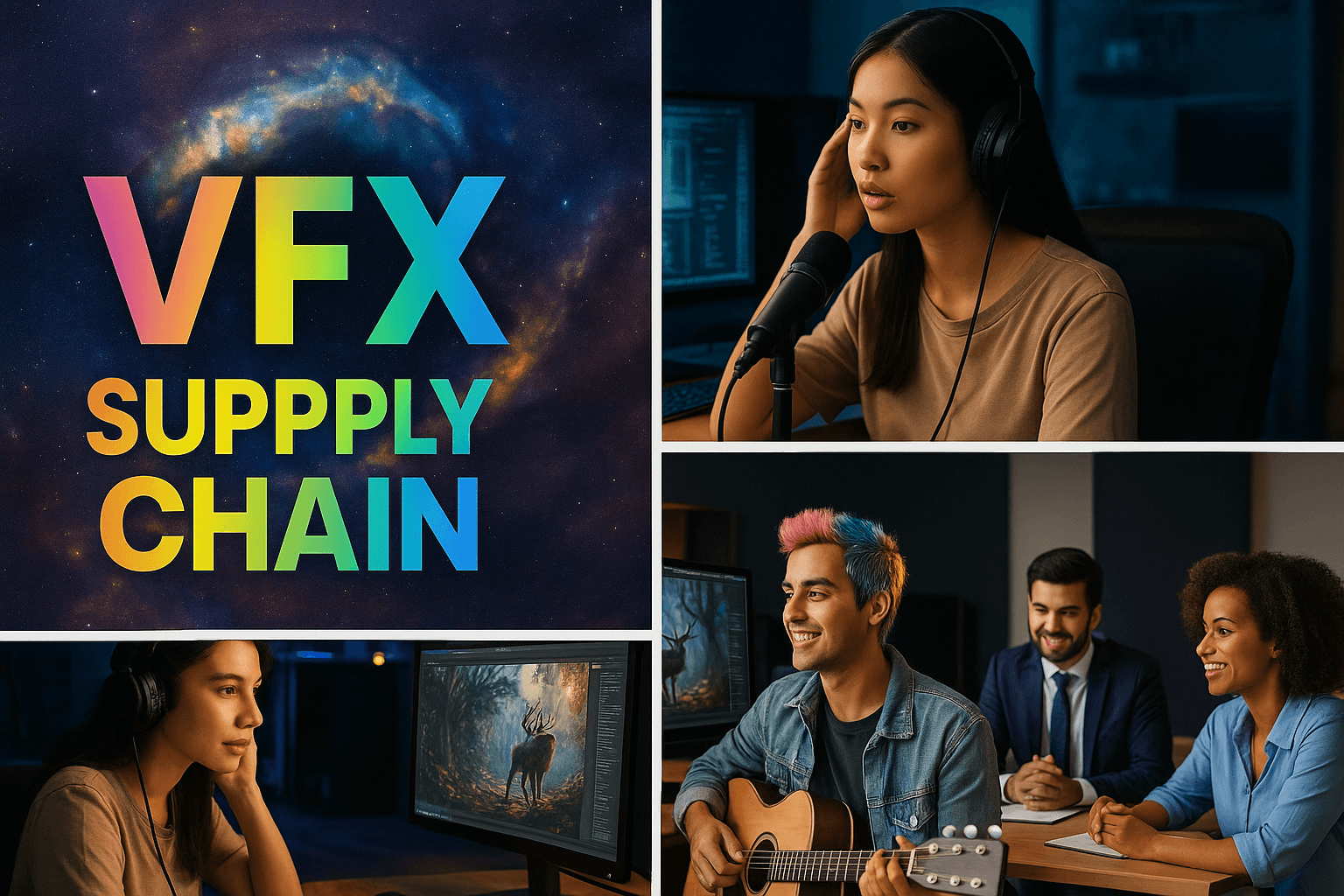VFX Supply Chain: A Masterclass in Visual Effects

Introduction
The global visual effects (VFX) market, which was valued at approximately $15.5 billion in 2022, is in a state of continuous transformation. As a senior M&E executive, you know that the traditional approach to VFX—where a vendor receives a completed cut and simply implements shots—is no longer a viable model for success.
The high demand for premium content, coupled with increasingly complex projects and tight deadlines, has created immense pressure on the legacy VFX supply chain. The stakes are high: a single misstep in the vendor-studio relationship can impact project budgets, timelines, and creative vision.
The new paradigm, as articulated by Framestore’s John Kilshaw, is one of early-stage collaboration and a human-centric approach that prioritizes talent and communication over pure reputation. This article provides a strategic framework for mastering the modern VFX supply chain, exploring how to balance creativity, technology, and production realities to achieve breathtaking results. I will demonstrate how leveraging structured intelligence is essential to navigating this new era of visual storytelling.
Table of content
- The Evolving VFX Supply Chain: From Implementation to Collaboration
- People, Not Reputation: The Human Factor in the VFX Supply Chain
- The Role of AI and Technology in the Modern VFX Supply Chain
- How Vitrina Empowers the Modern VFX Supply Chain
- Conclusion: The Future of the VFX Supply Chain is Here
- Frequently Asked Questions
Key Takeaways
| Core Challenge | The traditional VFX supply chain is not built for the modern era’s high-volume demand, requiring a shift from late-stage implementation to early, strategic collaboration. |
| Strategic Solution | Prioritize a human-centric, data-driven approach that vets vendors based on talent and a proven track record of collaboration, not just a company’s reputation or awards. |
| Vitrina’s Role | Vitrina provides the verified intelligence on companies, executives, and projects that enables you to find, vet, and connect with the right VFX partners early in the production cycle. |
The Evolving VFX Supply Chain: From Implementation to Collaboration
The modern VFX supply chain is defined by a shift in responsibility and timing. In the past, the VFX vendor’s role was often a pure implementation job, brought in after principal photography to add visual effects to an already-shot scene.
Today, many studios and showrunners are taking a more proactive approach, integrating VFX teams much earlier in the production cycle. John Kilshaw of Framestore describes how his team is sometimes brought in before a show is even greenlit, collaborating on concept art and visual direction to help shape scenes even before they are written.
This early involvement is not a luxury; it’s a necessity. It allows studios to plan more effectively, identify potential creative and technical challenges in pre-production, and ensure that the final product aligns with the original creative vision.
For this model to work, the client-vendor relationship must be built on trust and a shared understanding of the creative goals. This involves moving beyond a simple brief and engaging in a conversation about the “emotive beats” and story points of a scene, rather than getting bogged down in technical details like polygon counts.
The best clients, according to Kilshaw, are those who “let you into their world early”. This is the difference between a project that runs smoothly and one that struggles with creative and technical disconnects. Getting the first six to eight weeks of a project right—setting expectations and holding people accountable—is paramount to avoiding pain points later in the process.
For more on the business of visual effects, I recommend reading The Economics of Visual Effects: From Blockbusters to Episodic Content.
People, Not Reputation: The Human Factor in the VFX Supply Chain
In a globalized industry, talent can come from anywhere. The podcast with John Kilshaw reinforces this idea, arguing that if you strip away all of a company’s awards and reputation, you’re left with a “highly talented group of people”. In the new VFX supply chain, the focus has shifted from a company’s history to the specific talent and creative vision of its artists and supervisors.
This requires a new approach to sourcing and vetting. Simply looking at a list of a studio’s past credits or awards is no longer sufficient. Instead, you must be able to identify and engage with the key individuals who will be driving the creative vision for your project.
This approach also extends to a broader appreciation of global storytelling traditions. As a global executive, you should be open to different narrative structures and creative approaches that can inspire fresh ideas and help you break through the noise of an oversaturated content market.
This means looking beyond established players in traditional markets and exploring vendors and artists in emerging regions who can bring a new perspective to your project. This is a critical step in building a flexible and resilient VFX supply chain that is not beholden to a single region or style of production.
The Role of AI and Technology in the Modern VFX Supply Chain
The rise of new technology, including AI and generative AI, is a significant driver of change in the VFX supply chain. These tools have arrived at the right time, as there is a massive appetite for content but a limited amount of capital to produce it.
According to a recent report, generative AI tools are enabling artists to automate mundane and repetitive tasks, which allows them to focus on creative problem-solving and achieve better results in less time. This shifts the unit economics of VFX, making it possible to achieve cinematic quality on an episodic budget.
However, as John Kilshaw noted, the biggest impact of AI is not on the tools themselves, but on how we use them to communicate. For a VFX supervisor, AI can act as a tool for visual representation, providing a physical manifestation of a creative idea that can be used to improve communication with a showrunner or a client.
It can also help us ask better questions and get to creative answers more quickly, allowing for more time to develop the “wonderful parts of the work” and create breathtaking moments. The balance is key; technology’s job is to give us more time for beauty, not to come at the expense of creative quality.
How Vitrina Empowers the Modern VFX Supply Chain
In this new landscape, relying on a fragmented pipeline of information is a significant liability. Vitrina provides a centralized, global source of truth that empowers executives to navigate the complexities of the modern VFX supply chain with precision.
Vitrina’s platform allows you to find and vet partners not just by their reputation, but by their specific capabilities and project history. You can search for studios and vendors by service type, region, and previous projects, enabling you to build a qualified pipeline and identify emerging players who may not have a strong public footprint.
Vitrina’s robust company profiling provides detailed data on ownership, service scope, and reputation indicators, giving you the information needed to make informed decisions and build strategic partnerships. You can also map key executives and decision-makers, gaining access to the verified contacts you need for direct outreach.
This is the intelligence needed to move beyond a simple implementation job and into a true, early-stage collaboration, ensuring your project has the creative and technical support it needs from day one. This is the difference between a project that simply gets finished and one that hits a home run.
Conclusion: The Future of the VFX Supply Chain is Here
The modern VFX supply chain is more than just a logistical challenge; it is a strategic imperative.
The shift from a late-stage, implementational role to an early, collaborative one is non-negotiable for any studio or production company seeking to deliver premium content at scale. Success is now a function of how effectively you can balance creative vision with production realities, and how quickly you can find and engage with the right talent and partners in a global, fragmented market.
The ability to do this consistently is the mark of a forward-thinking executive.
Ultimately, a platform like Vitrina de-risks this entire process. It provides the structured, real-time intelligence that allows you to move beyond manual research and guesswork. By leveraging data to find partners, vet talent, and monitor the competitive landscape, you can ensure that your VFX supply chain is a force multiplier, not a bottleneck.
This is not just about making smarter decisions; it’s about enabling a new level of creative and strategic freedom. Ready to make smarter, faster decisions in the new era of the VFX supply chain? Sign-up Today
Frequently Asked Questions
The VFX supply chain has shifted from a late-stage, post-production role to an early, collaborative one. Many studios are now involving VFX vendors in pre-production, sometimes even before a show is greenlit, to help shape the creative vision and identify technical challenges early on.
Generative AI tools are changing the role of a VFX supervisor by enhancing communication and creative expression. AI can provide physical representations of creative ideas, helping supervisors and clients align on a vision more quickly. It also automates repetitive tasks, allowing artists to focus on more complex, creative work.
Leading studios balance cost and creative quality by leveraging new technology to work more efficiently. The goal is to get to the “exceptional” parts of the work faster, which affects cost but also ensures more time is spent on developing breathtaking moments. The key is to ensure cost never comes at the expense of quality.
According to experts like John Kilshaw, the first six to eight weeks of a project are the most important for VFX. This is when expectations are set and creative foundations are established. Getting this early stage right ensures the project runs smoothly and avoids major issues later in the process.

























